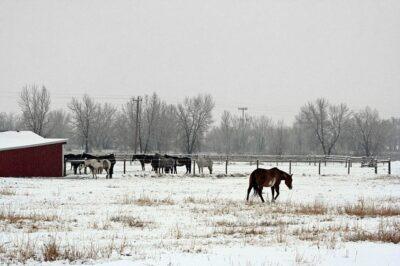One of the annual challenges on the homestead farm is keeping a fresh water supply available to livestock during freezing temperatures.
Depending on your climate, this can be for a few days of freezing weather — or months of sub-zero temperatures.
The first rule is to utilize every bit of solar energy that you can. That means placing water troughs where they will get the most sun during daylight hours. You should also place the troughs where they will get the least amount of wind.
The wind dissipates accumulated heat and causes the water to get to the freezing point faster, and it prevents it from reaching its highest possible temperature during daylight hours.
Diatomaceous Earth: The Best All-Natural Wormer For Your Livestock
Next, use either black plastic for your troughs, or paint them black with flat black paint. You should do this inside and out. Be sure and properly prepare the surface so that paint will adhere to it. You don’t want your livestock drinking paint chips.
For added heat, you can place a black tarp over the top with a hole for access to the water. This will usually work for cattle and horses, but pigs will tear it off before you get back to the house.
For pigs, you are better off to use painted black plywood or metal. You can put a small hinged door on it, as they will use their nose and raise the lid to drink.
Another trick we have used with good success is to bury as much of the water trough as you can and/or mound dirt up around the sides. This will give you some added thermal heat from the ground.
This can be a challenge for large stock tanks that are used for cattle and horses, but for hogs it works very well. I use plastic 55-gallon drums sawed in half, length-wise. Bury the entire trough except for about three inches. One word of warning on this method: Do not use these if you have small pigs that could fall into the trough and drown or manage to get out but freeze to death.
Everything You Need To Know To Keep A Cow Healthy, Happy, And Productive…
If you try these methods and it still doesn’t work, you will have to start looking at alternative methods.
Submersible 12-volt water heating elements can be a good solution if you have months of sub-zero temperatures. These can be used with a battery bank and solar set-up, or solar and add a wind turbine for a dump diversion load.
If you have a hillside, you can set up your trough in the fall by leveling off a spot, which will give you some protection on the uphill side from the ground. On the downhill side, you can dig back under the tank to make room for a small propane heater. I have done this when it was the only choice for a few days of sub-zero weather that threatened to turn a 100-gallon water trough into an unusable chunk of ice until spring.
Try these tricks to help minimize the times you need to resort to more expensive and labor-intensive methods.
What advice would you add? Share your winter water tips in the section below:
 Off The Grid News Better Ideas For Off The Grid Living
Off The Grid News Better Ideas For Off The Grid Living






